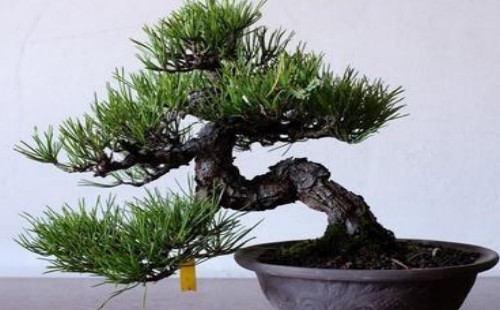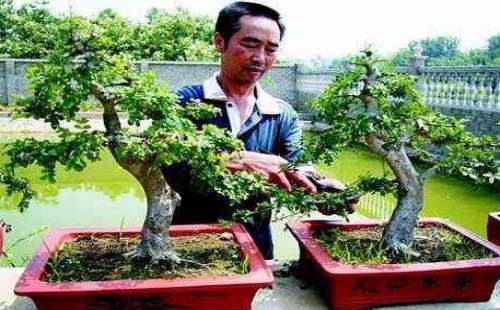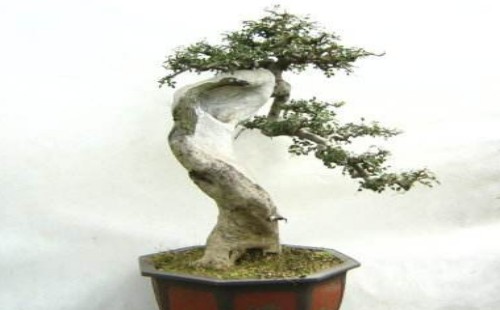Modeling techniques of qu Gan Bonsai
Qu Gan style bonsai is not only very graceful in posture, but also varied and colorful, but the modeling techniques used are the same, ever-changing and not separated from its clan. Because of this, we often need to pay attention to observe the growth form of various tree species in nature, feel its beautiful side through its appearance characteristics, and then express it in the form of bonsai creation, which is the charm of bonsai production.

However, the original external form of trees is not enough to meet our needs of bonsai creation. Therefore, the later processing and artistic creation are also very important. If the congenital conditions of trees can not meet the requirements of making dry bonsai, we can generally change the original shape of the trunk with the help of external force and let it deform according to our expected effect. Of course, if the trees themselves have been destroyed by wind and rain for a long time and honed by the years in the wild environment, they will retain a more beautiful plant shape. Therefore, for such trees, they often have more advantages in the modeling of bonsai.
The main purpose of making qu dry bonsai is to make its trunk and branches show a curved and changeable state, but at the same time it should reflect the natural and ancient charm to avoid obvious traces of artificial carving. For June snow, five-needle pine, black pine, gold pine, elm and other trunk with a certain degree of toughness of the tree species, it is more suitable to make qu dry bonsai. On the other hand, the qu-dry bonsai often has the characteristics of exaggeration in shape. In addition to the inherent characteristics of these curved bars, they can also be realized by manual processing and cultivation.
I. Young tree cultivation
Sometimes we are unable to dig trees from the wild, and at the same time, we are not willing to spend money to buy them from an economic point of view. In that case, we can cultivate bonsai trees by propagating seedlings. However, the process of young tree cultivation is often time-consuming, especially the seedlings, but the effect is often better to make the curved stem shape from an early age. Generally, the trunk of 1-2-year-old young trees is bent and shaped with wire, and its winding is made into S-shaped, spiral-shaped or two-curved half-shape. However, the focus of the operation is to top the branches and upper parts on both sides.
In the process of implementation, the branch is placed near the center point of the curved part, that is, the trunk protrudes outward. If there is a deviation in the position of the branch, it can be adjusted properly in the later stage until it reaches the best ornamental state. On the other hand, we also need to be careful on the issue of topping, which is generally divided into two cases: one is to make a natural modeling effect, and the other is to guide the top branches properly through reasonable pruning, and the other is to make a cloud-like model. the top branches were treated by the combination of pruning and flat binding.
2. Pruning and storing branches
Truncation and branch storage is a common method in the process of bonsai stump cultivation. The original is mainly to truncate the trunk at the upper part of the first-class branch at a suitable height, while tilt traction should be done to the remaining branches. And sometimes one cut-off may not be able to achieve the desired effect, so we can also carry out the second or third cut-off treatment, generally up to 3 times, we can often achieve the dry effect we need. By doing so, it tends to be more natural than bending the trunk directly.
The modeling method of cutting and storing branches is relatively flexible, which can make the trunk into an S-shaped shape, a curved shape with a large bend at the lower end and a small bend at the upper end, and even an oblique trunk at the lower end, while the upper end is S-shaped, and so on. In short, the creative techniques are more flexible and diverse. Specifically, according to the original characteristics of the pile scene to take reasonable means to be processed and built, so that it is in line with the aesthetic at the same time can also be excessive natural.
Third, rough dry to take bends
For dried tree stump bonsai, rough drying and bending treatment is also an important means. After digging up the stump, if we find that the branching effect on both sides of the straight trunk is better under the curved dry shape, but the trunk is relatively strong and is not conducive to the bending shape, then we can saw a certain number of holes where we need to bend. And then bend it. But pay attention to squeeze the depth of the saw, about 1x3 of the trunk diameter is appropriate. And in the process of bending the trunk, all protective measures should be taken, and a strip of cloth can be used to wrap it tightly to prevent it from breaking when bending.
Time: 2019-06-06 Click:
- Prev

Treatment of Branches in the Modeling of Fraxinus chinensis Bonsai
Pruning is one of the most commonly used means of tree bonsai modeling, and how to prune branches to be more aesthetic has always been worthy of bonsai creators to explore. However, for different creators, their creative personality, thinking, temperament, self-cultivation, preferences and so on are often different.
- Next

Preliminary shaping of tree stump bonsai
Tree stump bonsai often adopts different modeling techniques due to different tree species, and the effect of bonsai produced is also very different. Although the modeling techniques are different, the bonsai produced by the tree stump will have their own advantages due to their different shapes. However, before making tree stump bonsai, we first need to dig up the stump landscape.
Related
- Fuxing push coffee new agricultural production and marketing class: lack of small-scale processing plants
- Jujube rice field leisure farm deep ploughing Yilan for five years to create a space for organic food and play
- Nongyu Farm-A trial of organic papaya for brave women with advanced technology
- Four points for attention in the prevention and control of diseases and insect pests of edible fungi
- How to add nutrient solution to Edible Fungi
- Is there any good way to control edible fungus mites?
- Open Inoculation Technology of Edible Fungi
- Is there any clever way to use fertilizer for edible fungus in winter?
- What agents are used to kill the pathogens of edible fungi in the mushroom shed?
- Rapid drying of Edible Fungi

